There are several interesting medals that come up from time to time which were not produced by the central government of South Korea. I plan to highlight some of those medals here.
Please bear with me, this page is a work in progress.
Martyred Youth Medal

반공 청년운동 순국 열사 기념비
Dedication Ceremonies held on June 25, 1969
Picture Source: “New Daily” Newspaper article

반공 청년운동 순국 열사 기념비
Located on Namsan (South Mt.) in Seoul
(You can see the Seoul Tower in the background)
After the liberation of Korea from Japan, there were fierce power struggles between left-wing, pro-communist elements and the right-wing pro-democracy idealists. Power struggles also existed within the two different ideological camps of left and right. At that time, youth organizations such as the Korea Independence Youth Group 대한독립청년단, the Liberation Youth Association 광복청년회, the Seobuk Youth Association 서북청년회, the Seocheong 서청 (西靑: Northwest Youth Association founded Nov. 30, 1946), the Minjok Youth Group 민족청년단, the Tae Dong Youth Group 대동청년단 (大同靑年團), the National Salvation Youth League 구국청년총연맹을 and the Young Chosŏn General Alliance 청년조선 총동맹 were formed. The Tae Dong Youth League, founded Sept. 21, 1947, was formed around Kim Gu’s 김구 (金九) supporters, while the organizations supporting Syngman Rhee founded the National Salvation Youth League on February 5, 1948. Right-wing youth organizations, which received strong support from the US military police at the time, wielded unbridled power, especially after 1946. However, not all right-wing youth organizations received cooperation and protection from the US military government. The Korean Police supplied the weapons.
After the establishment of South Korea on Aug. 15, 1948, Syngman Rhee needed to secure his support / power base. He organized a new unified youth movement group, the Tae Han Youth Corps 대한청년단 (大韓靑年團). This youth group is also known as Hancheong 한청(韓靑). It was established on Dec. 19, 1948 and was a quasi-national organization with Syngman Rhee as its president. After Kim Gu’s assassination in 1949, the Tae Dong Youth League, along with several other youth organizations, were integrated and absorbed by the Tae Han Youth League, under orders from Syngman Rhee, the president of South Korea. Even so, some elements of the original organization continued to act independently, so it is not possible to get an accurate date for its complete disbandment.
In 1949, after most of the U.S. Army had withdrawn from Korea, the Tae Han Youth Corps was reorganized into the Youth Defense Corps and used as a reserve military organization. Later, during the Korean War, the Youth National Guard became the basis for the creation of the Korean National Guard. During the Korean War, youth organizations cooperated with, and served in, military and police operations. Syngman Rhee disbanded his Tae Han Youth Corps on Sept. 10, 1953, after the Korean War.
On December 23, 1962, almost 10 years after the disbandment, 18 people who had been members of the Tae Han Youth Corps gathered to discuss the future possibility of creating an organization and holding memorial services. On Oct. 10, 1963, some 2,118 representatives of youth activists from across the country gathered at the Seoul Civic Center Auditorium. They created an organization using the name Cheongwoohoe 청우회 (晴雨會). At that time, it was a social organization registered with the Ministry of Culture and Information. Its purpose was to remember and commemorate the history of the Youth Movement in the anti-communist struggle and those who had perished in that struggle. The following day, the Martyred Youth Medal was produced. In 1975, the name of the organization was changed to the Korea Youth Movement Association 한국청년운동협의회. It was renamed the Founding Youth Movement Council 건국청년운동협의회 in 1987. And later, in 1995, the organization was renamed to the National Assembly of the Republic of Korea 대한민국건국회. The organization obtained a corporation license from the Public Information Agency In 1997. Later, in February 2017, the name was changed to “National Association for National Unification of Korea” 대한민국통일건국회, and in November 2017, it was approved as a non-profit corporation by the Ministry of Public Administration and Security and continues until now. They maintain a website at http://www.ucgeonguk.co.kr/.
There is a “Monument to the Martyrs of the Anti-Communist Youth Movement” 반공 청년운동 순국 열사 기념비 located on Namsan (남산 South Mountain) in Seoul. It is just across from the cable car platform near Sowol-gil 소월길, and somewhat separated from the normal tourist attractions. The memorial honors the 17,274 anti-communist youths who died fighting against communist leftists. This number does not include those youths who were members of the military or police forces. The groundbreaking ceremony was held on June 6, 1968, and the memorial was completed on June 25, 1969. The monument was funded by donations from President Park Chung-hee, Korean Politician and businessman Kim Seong-gon 김성곤 (金成坤·1913~1975) and others. In 1975, the 1st Anti-Communist Youth Movement Joint Memorial Ceremony 제1회 반공청년운동 순국자 합동추념제 was held. These ceremonies continue to be held every June, in front of the monument.
In doing the research for this article, the name of the organization “Cheong Woo Hoe” gave me no end of problems. There was virtually nothing on the internet when searching for “Cheong Woo Hoe” in English or in Korean. These searches did bring up lots of youth organizations, but nothing to tie it to the medal featured with this article. It wasn’t until I started searching for information using the Chinese characters, 晴雨會, that I was able to connect the dots. The pickings were still slim, but better. The name “Cheong Woo” means “Rain or Shine”. It should be thought of in the same manner as the unofficial motto of the U.S. Post Office, “Neither snow nor rain nor heat nor gloom of night stays these couriers from the swift completion of their appointed rounds”. So, the name of the organization that issued the medal is technically the “Rain (or) Shine Association”.
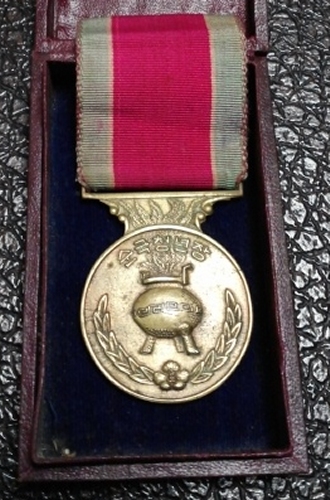
in the original Case
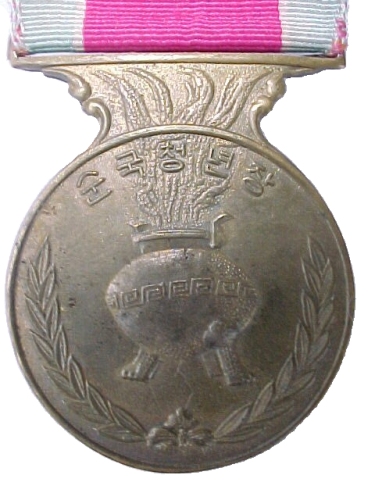
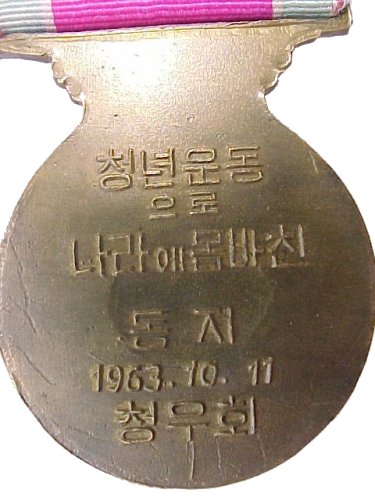
The Bank of Korea
In 1910, the Governor-General of Korea established the Hankuk Bank 한국은행 (韓國銀行), taking the place of the privately held Korean branch of (Japanese) Daiichi Kokuritsu Ginkō 株式会社第一銀行 (First National Bank), which in 1878 had established a branch facility in Korea. The Hankuk Bank assumed responsibility for the banknotes issued by the Dai-Ichi Bank that were still in circulation (approx. 12,000,000 yen). After the annexation of the Korean Empire by Japan in 1910, the bank was reorganized and its name was changed to Bank of Chosŏn 조선은행 (朝鮮銀行) which reflected the official Japanese name for Korea. The Bank of Chosŏn was the central bank of Colonial Korea, and (later) of South Korea. The bank was a privately held corporation with stock owned by a number of Japanese banks and companies; however, its board was appointed by the Governor-General of Korea. The bank was responsible for issuing currency in Korea, regulating domestic prices, and the servicing of international trade. It had branch offices in Manchukuo, China, London, New York City and in Japan. The bank issued Korean yen (¥) from 1910 to 1945 and won (₩) from 1945 to 1950. The bank was dissolved in 1950 and replaced by the newly formed Bank of Korea 한국은행 (韓國銀行). The Bank of Korea is the central bank of the Republic of Korea and issuer of Korean won (₩). It was established on 12 June 1950 in Seoul, South Korea. The bank’s primary responsibility is price stability.
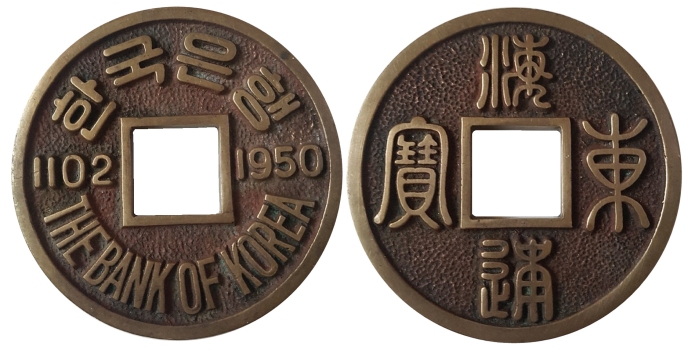
The obverse inscription 한국은행 ‘Bank of Korea’ is repeated in English at the bottom. The date 1102 is probably a reference to the reverse inscription, which is in seal script. In traditional script, it is 海東通寶 and translates as Eastern Sea Currency. This inscription is found on Koryo Dynasty coins dating to 1097-1105 CE.
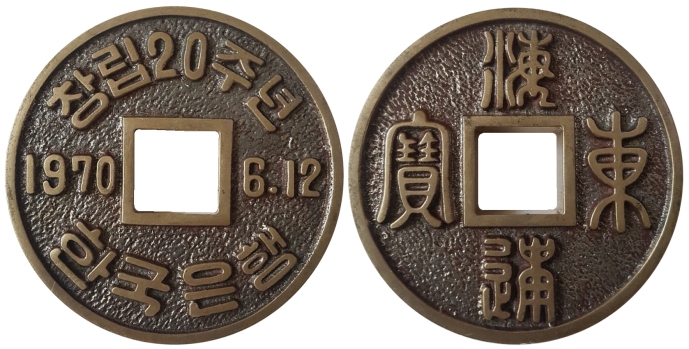
The obverse inscription at the top is 창립20주년 ’20th Anniversary’. The bottom inscription is 한국은행 ‘Bank of Korea’. Across the center is the date ‘June 12, 1970’. The reverse is identical to the medal at the left.
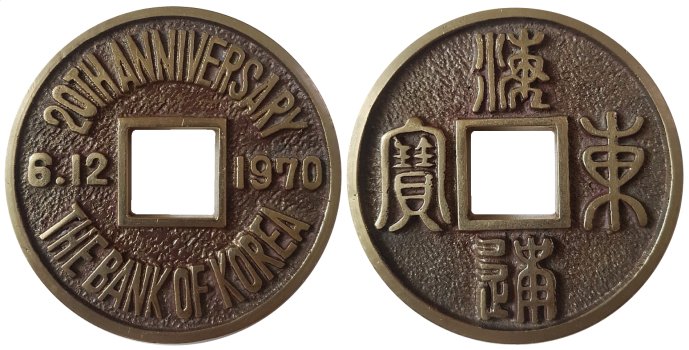
No need for translation on this one. ’20th Anniversary / Bank of Korea’ and the date, ‘June 12, 1970’. The reverse is identical to the two medals at left.
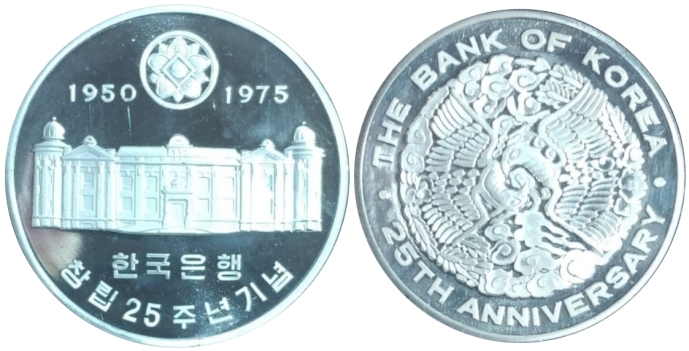
The obverse inscription starts with the date ‘1950’ and ‘1975’. Below the bank building is the inscriptions 한국은행 ‘Bank of Korea’. The bottom inscription is 창립25주년기념 ’25th Anniversary Celebration’.
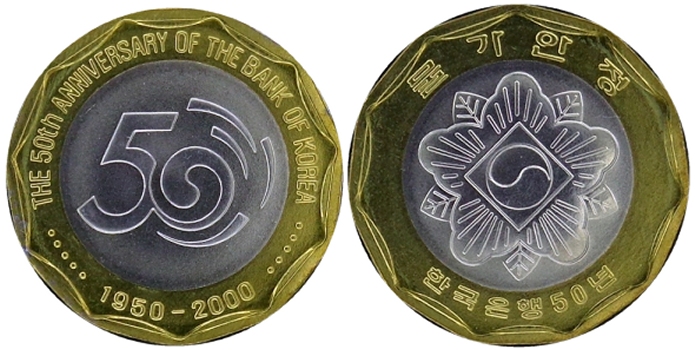
On the obverse is the inscription ‘the 50th Anniversary of the Bank of Korea • 1950-2000’. On the reverse the inscription 물가안전 ‘Price Stabilization’ and 한국은행50년 ‘Bank of Korea 50 years’.
(The bank’s primary purpose is price stability.)
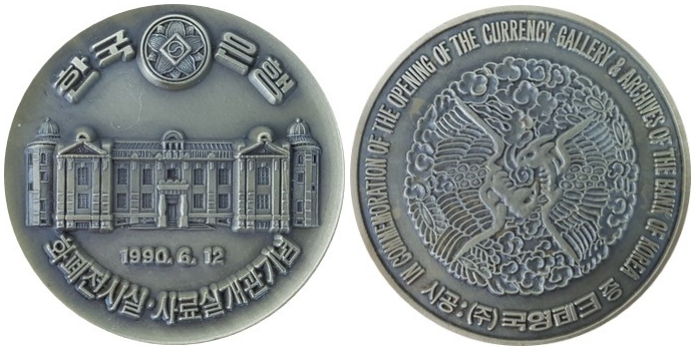
The obverse inscription is 한국은행 ‘Bank of Korea’ at the top. Under the building is the date ‘1990.6.12’ and at the bottom is 화폐전시실•사료실개관기념 ‘Commemoration of the Opening of the Currency Exhibition Room and Historical Materials Room’. The medal measures 68 mm across, by 7 mm thick and weighs 174 g.

On the obverse is the inscription한국은행방문기념 ‘Bank of Korea Visit’ and below is ‘In Commemoration of your Visit to the Bank of Korea’. The reverse inscription is 한국은행 ‘Bank of Korea’. The medal has a 60 mm diameter.
The All-Korean Student’s Association

Since I have been unable to find the organization’s date of establishment, 1945 could indicate the year in which it was established. But “1945” could also be a rallying cry for the movement against the Trusteeship as outlined in the 1945, Joint Declaration of the Moscow Trilateral Conference.
A few quick words about the Korean inscription. The Chinese characters, at the bottom of the reverse, can be interpreted in several ways, such as ‘National Federation of Students’, ‘All-Country Student Council’, ‘All-Country Student Association’, etc. Since this was a wholly Korean association, rendering the translation as the ‘All Korean Student’s Association’ is not an issue.
The Moscow Trilateral Conference 모스크바 삼상 회의, also known as the Moscow Conference of Foreign Ministers, or the Interim Meeting of Foreign Ministers, was held from Dec. 16th to the 25th of 1945. It was a meeting of three countries: the United States, the United Kingdom and the Soviet Union and was primarily an extension of three earlier Allied World War II Conferences (Cairo 1943, Yalta 1945 and Potsdam 1945). The meeting centered on seven agenda items, which included establishing peace and other Far Eastern issues. One of the agenda items was the trusteeship issue regarding the Korean Peninsula. At the conclusion of the meeting, a Joint Declaration was officially issued on Dec. 27th. It was publicized in Korea on December 28. The sections concerning Korea consisted of four paragraphs. The third paragraph called for the establishment of a Joint Commission, under the control of a four-power trusteeship (China, Great Britain, Soviet Union and the United States). The Joint Declaration included a statement that the trusteeship may be needed for up to five years before Korea could attain national independence. Initially, both sides of the Korean political spectrum, left and right, opposed this trusteeship plan. Many Koreans felt that the plan made their country a vassal of the four powers. In time, it was found that the United States and the Soviet Union interpreted the meaning of trusteeship differently. They both approached it as a means to establish a Korean government friendly to their respective countries.
The All-Korean Student’s Association 전국학생총련회 (全國學生總聯盟) was formed immediately after the Moscow Trilateral Conference. (I have been unable to determine the date of establishment.) They actively demonstrated against the trusteeship. On January 3, 1946, the Communist Party, which had initially been opposed to the trusteeship, reversed its position and issued a statement supporting it. Korea’s leftist student movement moved in perfect lock-step with the commands of the Communist Party, so they also reversed their position and now supported the trusteeship. This shift of the left led to intensified confrontations between the left and right student organizations. Keep in mind, that right and left wing organizations existed throughout the whole of the Korean peninsula. Student representatives from right-wing groups, such as, the Independent Student Front 독립 학생 전선, the International Student Alliance 유학생 동맹, the Gyeongseong University Alumni Association 경성 대학 동지회, and the National High School Student Federation 전국 고등학생 연맹, held several meetings in Namsan-dong, Seoul to reflect on the current situation and to promote a more effective student movement. From these meetings, it was decided to disband all existing organizations and form a single collective body. According to this resolution, on July 31, 1947, the National Student Federation 전국 학생 총연맹 was formed at the Central Chapel in Insa-dong, Seoul.
Then, in January 1949, after the establishment of the Republic of Korea, ‘Guidelines for Organizing Student Protection Corps’ 학도호국단조직요령 were promulgated. The organization of the country’s secondary schools was completed in February, and universities followed suit during March and April. The National Student Federation ended with the establishment of the Korean Student Protectorate Corps 대한학도호국단 on April 22, 1949. At the same time, the Secretariat of the National Student Protection Corps was established within the Ministry of Education, and in September of the same year, the ‘Regulations of the Korean Student Protection Corps’ 대한민국학도호국단규정 were promulgated by presidential decree. The Student Defense Corps was not only organized by central and local regions, but was also organized nationwide, with students and faculty members from secondary schools through universities as members.
Welcome, Apollo Astronauts

After the Apollo 11 Astronauts returned safely to earth, they went on a world tour. This medal was used in Seoul during that tour. At the top of the obverse, there is the inscription 환영 ‘Korean English’. Below this are two lines, one in English and one in Korean, which should be read as a single line. ‘Welcome’ 아폴로 우주인방한 ‘Welcome Apollo Astronauts’. At the very bottom is the date: 1969.11.3.
I have no information on the reverse.
